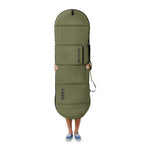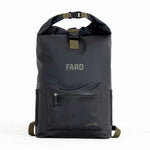If you’re a surfer, your board isn’t just a piece of equipment—it’s your ticket to freedom, adventure, and the perfect wave. Protecting that board is a priority, especially when transporting it to and from the beach. Roof racks are a convenient way to carry your board, but they also expose it to sun, wind, rain, and debris. That leads many surfers to wonder: Do I need a surfboard bag for my roof rack?
The answer is simple: while it’s not absolutely essential for every short drive, a surfboard bag dramatically increases the safety, convenience, and longevity of your board. In this guide, we’ll break down the advantages, explore travel and cost considerations, share tips for choosing the right surfboard bag, and explain why investing in a quality bag—like those from FARO—can save you time, money, and frustration in the long run.
Advantages of Using a Surfboard Bag on a Roof Rack
Transporting your surfboard without a bag is a bit like driving without a seatbelt—it may work fine most of the time, but when something goes wrong, the damage can be costly.
Protection from External Elements
Surfboards are delicate. Foam, fiberglass, and resin can all be compromised by environmental stress. A bag shields your board from:
-
Sun exposure: UV rays weaken resin and can lead to delamination (where the fiberglass separates from the foam). Over time, boards left exposed fade, yellow, or warp. A bag with UV-blocking fabric prevents this.
-
Moisture: Rain, fog, and salt-laden sea air seep into cracks and cause deterioration. Waterproof or water-resistant bags help keep your board dry.
-
Wind and grit: Driving at 60+ mph turns road dust and debris into tiny projectiles. A bag keeps your board’s surface smooth and ding-free.
Prevents Scratches, Dings, and Cracks
Roof racks and tie-down straps, while useful, are notorious for leaving pressure marks. A bag provides a cushioned layer, reducing the risk of dings caused by over-tightened straps or shifting boards.
Impact Resistance
Anyone who’s driven down a bumpy coastal road knows how much boards can move on a rack. Padded surfboard bags absorb shock, reducing the risk of stress cracks or snapped fins.
Security and Convenience
Surfboard bags aren’t just about protection—they also make your trips to the beach easier.
Greater Stability on Roof Racks
Most surfboard bags come with integrated strap guides or reinforced anchor points that reduce board movement. This means fewer mid-drive stops to check your straps and more peace of mind on long hauls.
Easier Loading and Carrying
Handles, zippers, and padded straps make loading boards far simpler. Instead of balancing an awkward, slippery board on your head or shoulder, you can grip the handles and carry with ease—even for longer walks from the car park to the sand.
Quieter Drives
Boards alone create noticeable wind resistance and whistling noises. A bag reduces drag by streamlining airflow. Less noise, less fuel consumption, and a more relaxed drive.
Longevity of Your Surfboard
Every surfer knows a good board doesn’t come cheap. A surfboard bag directly contributes to extending its usable life.
-
Shields from road debris: Stones, grit, and bugs can chip resin finishes.
-
Reduces sun damage: Heat and light fade colors and weaken the structure.
-
Preserves graphics and artwork: If you’ve invested in a custom-painted board, a bag ensures the design lasts longer.
Well-maintained boards not only perform better but also retain higher resale value when you’re ready to upgrade your quiver.

Travel Considerations
For surfers who travel often, surfboard bags are a necessity, not a luxury.
Long-Distance Drives
Boards can suffer more from a 200-mile car journey than from a week of regular surfing. A padded surfboard bag prevents long-haul damage from vibrations, strap pressure, and weather exposure.
Airline Travel
Airlines almost always require boards to be checked inside a surfboard bag. Without one, you may be denied boarding with your gear. Well-padded travel bags add extra layers of foam or insulation that protect your board from baggage handlers and conveyor belts.
Accessory Storage
Many surfboard bags have internal or external pockets where you can stow fins, wax, sunscreen, or wetsuits. Having one organized bag makes traveling simpler and reduces the chance of forgetting essential items.
Cost-Effective Investment
A surfboard bag pays for itself quickly.
-
Fewer repairs: One repaired ding can cost nearly as much as a budget bag.
-
Longer lifespan: Protecting your board delays the need for replacement.
-
Multi-board options: Some travel bags fit two or more boards, saving you money and hassle.
-
Resale value: A ding-free board fetches a better price secondhand.
Think of it as insurance for your surfboard—one small investment to protect a much larger one.
Choosing the Right Surfboard Bag
Not all surfboard bags are created equal. When shopping, consider:
-
Type of bag: Day bags are lighter, perfect for short drives. Travel bags are thicker and more padded for flights or road trips.
-
Size and fit: Always choose a bag slightly longer than your board. A snug fit provides better protection.
-
Material: Look for UV-resistant, waterproof fabrics. FARO bags use eco-friendly recycled materials that don’t compromise on durability.
-
Padding: Thicker padding (5mm–10mm) is ideal for maximum protection.
-
Extras: Compartments for accessories, reinforced zippers, and shoulder straps add convenience.
Shop FARO Surfboard Bags for eco-friendly, long-lasting options designed specifically for surfers who care about their boards and the planet.
Common Mistakes to Avoid
Surfers often make small mistakes that reduce the effectiveness of a surfboard bag. Avoid these pitfalls:
-
Leaving the bag in the sun: Bags get hot too. Don’t leave your board zipped inside for hours in direct sunlight.
-
Choosing the wrong size: Too loose means movement, too tight means stress on the board.
-
Ignoring the zippers: Rinse the zippers after exposure to salt water to prevent corrosion.
-
Skipping padding for flights: Day bags aren’t padded enough for airlines—always use a proper travel bag.

Where to Find the Best Surfboard Bags
You’ll find a variety of surfboard bags at surf shops or large online retailers like Amazon (no-follow). However, quality varies significantly.
For serious surfers, FARO surfboard bags stand out. FARO is known for blending function, durability, and sustainability. Features include:
-
Eco-friendly, recycled materials
-
UV and water resistance
-
Extra padding for reliable protection
-
Reinforced stitching and handles for easier carrying
-
Multiple sizes to suit shortboards, longboards, and fish
Looking for more? Check out our in-depth guide: Are Surfboard Bags Worth It? A Complete Guide for Surfers, or explore our Surf Travel Tips for eco-conscious wave chasers.
Conclusion
So, do you need a surfboard bag for your roof rack? Technically, you can drive without one, but the risks outweigh the savings. A surfboard bag protects against sun, rain, debris, scratches, and impact, while also making transportation easier and travel more convenient.
If you’re serious about keeping your board in excellent condition, prolonging its life, and getting the most from your investment, a surfboard bag is the way to go. For surfers who want gear built to last, FARO surfboard bags combine quality, function, and eco-friendly design.
Protect Your Board with FARO Surfboard Bags
Quick FAQs





